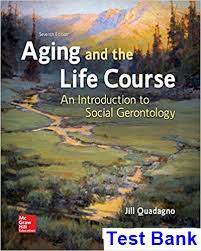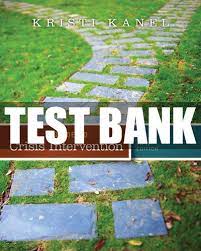Description
Test Bank For Aging And The Life Course An Introduction to Social Gerontology 7Th Edition By Jill
Chapter 02
Life Course Transitions
Multiple Choice Questions
1. (p. 28) Transitions are:
A. social changes that occur as one cohort replaces the other.
B. the impact of historical events on the entire society.
C. role changes individuals make as they leave school, take a job, marry, have children, or retire.
D. ways of using age as a social category to group people by status.
Accessibility: Keyboard Navigation
2. (p. 28) All of the following are characteristics of a trajectory except:
A. it can be a multiple pathway in ordering and timing life events.
B. it ranks individuals hierarchically in a social system.
C. it can consist of distinct gender differences in employment.
D. it has an impact on women’s income security in old age.
Accessibility: Keyboard Navigation
3. (p. 29) Which of the following statements is NOT a characteristic of age grade?
A. It occurs in every society.
B. Most societies have more clearly marked age grades for males than for females.
C. Societies may vary in the number of age grades.
D. Individual members of society can select the age grade they want to join.
Accessibility: Keyboard Navigation
4. (p. 29) In age-graded systems, _____.
A. people are categorized by the number of siblings in their families
B. each categorized group has the same role or grade
C. people are predominantly categorized by the differences in their ethnicity and race
D. males are ranked in hierarchical order according to their age group
Accessibility: Keyboard Navigation
5. (p. 29) One of the major methodological issues in research on the life course is:
A. collecting data to test various hypotheses.
B. selecting the appropriate sample size.
C. distinguishing among age, period, and cohort effects.
D. distinguishing between abstract and concrete concepts for the study.
Accessibility: Keyboard Navigation
6. (p. 30) Which of the following is an example of a cohort effect?
A. the shift in the attitudes of a country’s population toward gay marriage from the 1960s till the early 2000s
B. the shift in the average life expectancy of an older cohort from the 1960s till the early 2000s
C. the impact of the civil rights movement on the economy of the United States in the 1970s
D. the impact of the Great Depression on the rich and the poor
Accessibility: Keyboard Navigation
7. (p. 30) Which of the following is an example of a period effect?
A. the financial crisis of 2007-2008
B. the change in the attitude of the millennials about the baby boomers
C. the changes in the physical appearance of an individual over a period of time
D. the disappearance of the Malaysian Flight 370
Accessibility: Keyboard Navigation
8. (p. 31) The best research design to distinguish among age, period, and cohort effects is:
A. cross-sectional.
B. longitudinal.
C. secondary data.
D. participant observation.
Accessibility: Keyboard Navigation
9. (p. 30) The finding that older people are more politically conservative than younger people is an example of:
A. aging effect.
B. cohort effect.
C. period effect.
D. subculture effect.
Accessibility: Keyboard Navigation
10. (p. 30) According to research, support for gay marriage was lowest among:
A. the Millennials.
B. the Silent Generation.
C. the Echo Boomers.
D. the Swing Generation.
Accessibility: Keyboard Navigation
11. (p. 31) The longitudinal research design that focuses on the role that social support and personal relationships play in healthy aging is _____.
A. the Health and Retirement Survey
B. the Baltimore Longitudinal Study of Aging
C. the National Social Life, Health and Aging Project
D. the Asset and Health Dynamics among the oldest-old
Accessibility: Keyboard Navigation
12. (p. 32) Which of the following is not a technique used in qualitative research?
A. interviewing individuals using a survey instrument
B. participant observation
C. open-ended interviews
D. observing people in a natural setting
Accessibility: Keyboard Navigation
13. (p. 32) All of the following are characteristics of longitudinal research designs except:
A. they follow a particular group of people over time.
B. they provide data about differences between age cohorts.
C. they are costly.
D. they are factual because all of the same subjects remain in the study.
Accessibility: Keyboard Navigation
14. (p. 34) The term “age timetables” refers to:
A. the number of years spent in each phase of the life cycle.
B. appropriate ages for making various life course transitions.
C. the expected timing or deadline for life events.
D. timetables that order life events.
Accessibility: Keyboard Navigation
15. (p. 32) Which of the following is NOT an example of life course transition in the family sphere?
A. parenthood
B. grandparenthood
C. entering full-time employment
D. marriage
Accessibility: Keyboard Navigation
16. (p. 32) An advantage of longitudinal research studies is that they:
A. follow different groups of people at different points in time.
B. do not distinguish age effects from cohort effects.
C. provide data about differences between age cohorts.
D. do not require any investment as they monitor subjects at only one point in time.
Accessibility: Keyboard Navigation
17. (p. 32) A disadvantage of longitudinal research studies is that they:
A. fail to include children and teens in their research.
B. fail to distinguish age effects from cohort effects.
C. have a tendency to be biased as some people drop out over a period of time.
D. can only include people of different age cohorts at a single point in time.
Accessibility: Keyboard Navigation
18. (p. 33) The _____ clock orders major life events.
A. biological
B. social
C. time
D. age
Accessibility: Keyboard Navigation
19. (p. 34) One of the reasons for the “crowded nest” phenomenon is:
A. low wage for young workers.
B. young adults these days are much less independent from their parents than in the past.
C. unavailability of other housing alternatives.
D. parents prefer to have their adult children living with them.
Accessibility: Keyboard Navigation
20. (p. 35) The _____ refers to middle-aged people who have both dependent children and aging parents.
A. crowded nest
B. social clock
C. swing generation
D. sandwich generation
Accessibility: Keyboard Navigation
21. (p. 35) Social scientists have found that there is a sequencing in the order of later life moves. The second move is most likely to occur when:
A. older adults are seeking a comfortable lifestyle.
B. older adults encounter physical incapacity.
C. older adults develop chronic disabilities, a serious illness, or become widowed.
D. older adults have remarried.
Accessibility: Keyboard Navigation
22. (p. 38) For nineteenth-century women, _____ percent of their married lives were spent in childrearing.
A. 60
B. 20
C. 90
D. 50
Accessibility: Keyboard Navigation
23. (p. 40) One theory which seeks to explain why inequality increases with age is the:
A. age stratification theory.
B. age inequality theory.
C. theory of cumulative disadvantage.
D. demographic transition theory.
Accessibility: Keyboard Navigation
24. (p. 40) Which of the following statements is true of the theory of cumulative disadvantage?
A. It states that the past history of an individual has little relationship with the future behaviors of the individual.
B. It indicates that inequality among people 65 or older is the lowest of all age groups.
C. It highlights the influences of earlier life experiences on the quality of life in old age.
D. It proposes that the advantage of one group over another group remains constant at any period of time.
Accessibility: Keyboard Navigation
25. (p. 40) The government has the greatest impact on:
A. adolescence and young adulthood.
B. children and older adults.
C. adolescence and old age.
D. children and adolescence.
Accessibility: Keyboard Navigation
26. (p. 41) Why do most people think of “old age” as starting at 65?
A. That’s the age that most people retire these days.
B. That’s traditionally the age at which most health problems begin.
C. That’s the average age at which people become grandparents.
D. Prior to the year 2000, that was the age at which retired workers could begin receiving Social Security benefits.
Accessibility: Keyboard Navigation
27. (p. 42) Which of the following was not part of the experience of the sent-down youth in China?
A. Many were allowed to visit their families for only a few weeks every three years.
B. Marriage and childbearing were significantly delayed.
C. Most started out on the upper end of the occupational ladder.
D. They were more likely to go to college and eventually had higher incomes.
Accessibility: Keyboard Navigation
True / False Questions
28. (p. 28) The life course of individuals is shaped entirely by the individual.
FALSE
Accessibility: Keyboard Navigation
29. (p. 28) An example of a countertransition is achieving a bachelor’s degree at age 18.
FALSE
Accessibility: Keyboard Navigation
30. (p. 29) Age grades use age as a social category to group people by religious and sexual orientation.
FALSE
Accessibility: Keyboard Navigation
31. (p. 29) The basic assumption in measuring age effects is that changes due to aging reflect biological and physiological developments that are independent of specific times, places, or events.
TRUE
Accessibility: Keyboard Navigation
32. (p. 29) The best example of an aging effect is the civil rights movement of the 1960s.
FALSE
Accessibility: Keyboard Navigation
33. (p. 30) A cross-sectional research design consists of asking people in several age groups the same information.
TRUE
Accessibility: Keyboard Navigation
34. (p. 31) A major advantage of the longitudinal research design is that it compares subjects from different cohorts.
FALSE
Accessibility: Keyboard Navigation
35. (p. 31) The Health and Retirement Survey is an example of a cross-sectional research study reported to the government panels making policy decisions about families.
FALSE
Accessibility: Keyboard Navigation
36. (p. 32) A major disadvantage of the longitudinal research design is the cost.
TRUE
Accessibility: Keyboard Navigation
37. (p. 34) One distinctive change in the duration of a life course phase is the extension of adolescence.
TRUE
Accessibility: Keyboard Navigation
38. (p. 35) The period of old age is also another change in the duration of the life course. It may last as long as 45 to 55 years.
FALSE
Accessibility: Keyboard Navigation
39. (p. 35) If there are disorders in the sequencing of life events, there may be negative consequences for later life transitions.
TRUE
Accessibility: Keyboard Navigation
40. (p. 37) A number of studies have found that children who are overweight are much more likely than slim children to be obese as adults.
TRUE
Accessibility: Keyboard Navigation
41. (p. 39) Until recently, middle age was distinct from the rest of adult life.
FALSE
Accessibility: Keyboard Navigation
42. (p. 39) By the 1970s, the average couple had their first child by their late 30s and had a total of four children spaced two years apart.
FALSE
Accessibility: Keyboard Navigation
43. (p. 40) People who start life at an advantage are likely to experience increasing benefits as they age.
TRUE
Accessibility: Keyboard Navigation
44. (p. 41) The government has the greatest impact on two phases of the life course: adolescence and old age.
TRUE
Accessibility: Keyboard Navigation
Essay Questions
45. What are the major historical events that have affected your age cohort?
Answers will vary.
46. What is the ideal family size and how far apart should children be spaced?
Answers will vary.





Be the first to review “Test Bank For Aging And the Life Course An Introduction to Social Gerontology 7Th Edition By Jill”